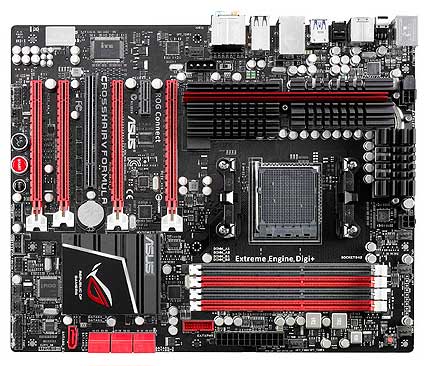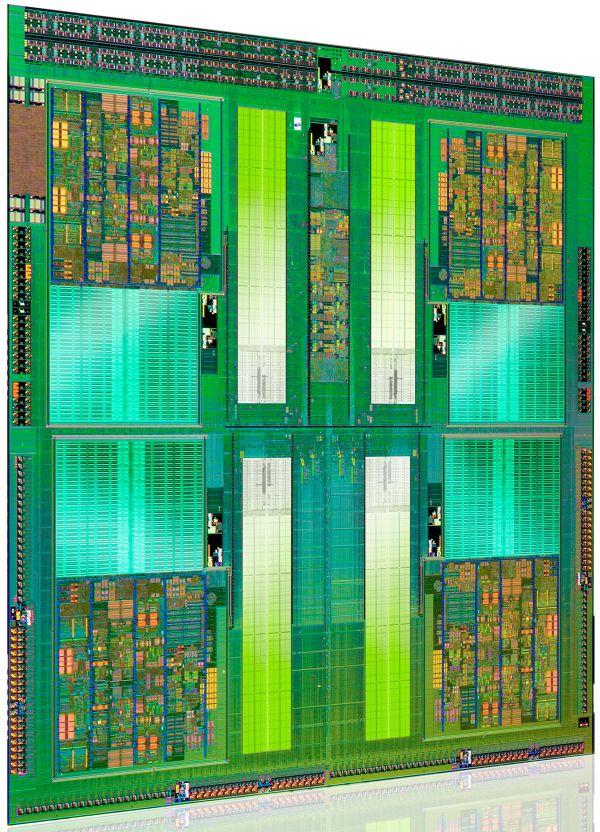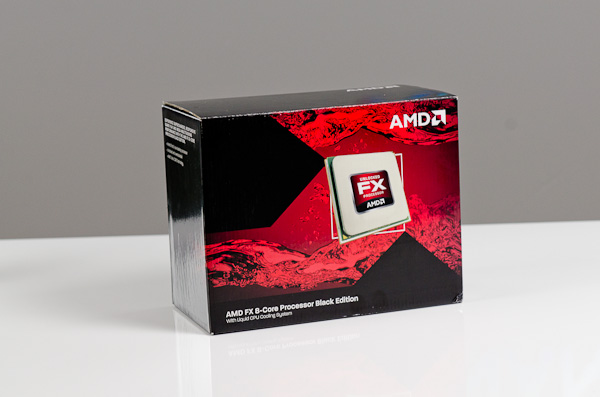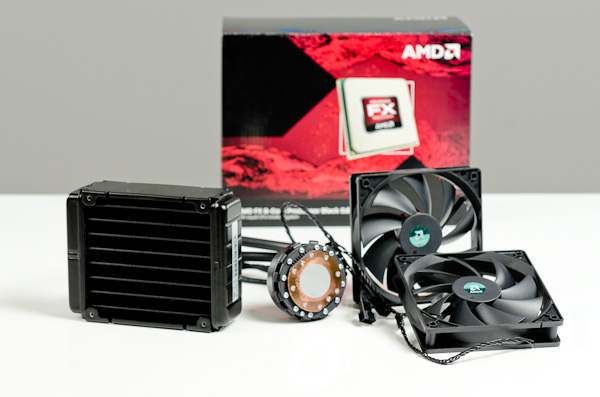The Bulldozer Review: AMD FX-8150 Tested
by Anand Lal Shimpi on October 12, 2011 1:27 AM ESTAMD has been trailing Intel in the x86 performance space for years now. Ever since the introduction of the first Core 2 processors in 2006, AMD hasn't been able to recover and return to the heyday of the Athlon 64 and Athlon 64 X2. Instead the company has remained relevant by driving costs down and competing largely in the sub-$200 microprocessor space. AMD's ability to hold on was largely due to its more-cores-for-less strategy. Thanks to aggressive pricing on its triple and hexa-core parts, for users who needed tons of cores, AMD has been delivering a lot of value over the past couple of years.
Recently however Intel has been able to drive its per-core performance up with Sandy Bridge, where it's becoming increasingly difficult to recommend AMD alternatives with higher core counts. The heavily threaded desktop niche is tough to sell to, particularly when you force users to take a significant hit on single threaded performance in order to achieve value there. For a while now AMD has needed a brand new architecture, something that could lead to dominance in heavily threaded workloads while addressing its deficiencies in lightly threaded consumer workloads. After much waiting, we get that new architecture today. Bulldozer is here.
It's branded the AMD FX processor and it's only available in a single die configuration. Measuring 315mm2 and weighing in at around 2 billion transistors (that's nearly GPU-sized fellas), Bulldozer isn't that much smaller than existing 45nm 6-core Phenom II designs despite being built on Global Foundries' 32nm SOI process. Both die area and transistor count are up significantly over Sandy Bridge, which on Intel's 32nm HKMG process is only 995M transistors with a die size of 216mm2. This is one big chip.
| CPU Specification Comparison | ||||||||
| CPU | Manufacturing Process | Cores | Transistor Count | Die Size | ||||
| AMD Bulldozer 8C | 32nm | 8 | 1.2B* | 315mm2 | ||||
| AMD Thuban 6C | 45nm | 6 | 904M | 346mm2 | ||||
| AMD Deneb 4C | 45nm | 4 | 758M | 258mm2 | ||||
| Intel Gulftown 6C | 32nm | 6 | 1.17B | 240mm2 | ||||
| Intel Nehalem/Bloomfield 4C | 45nm | 4 | 731M | 263mm2 | ||||
| Intel Sandy Bridge 4C | 32nm | 4 | 995M | 216mm2 | ||||
| Intel Lynnfield 4C | 45nm | 4 | 774M | 296mm2 | ||||
| Intel Clarkdale 2C | 32nm | 2 | 384M | 81mm2 | ||||
| Intel Sandy Bridge 2C (GT1) | 32nm | 2 | 504M | 131mm2 | ||||
| Intel Sandy Bridge 2C (GT2) | 32nm | 2 | 624M | 149mm2 | ||||
Update: AMD originally told us Bulldozer was a 2B transistor chip. It has since told us that the 8C Bulldozer is actually 1.2B transistors. The die size is still accurate at 315mm2.
Architecturally Bulldozer is a significant departure from anything we've ever seen before. We'll go into greater detail later on in this piece, but the building block in AMD's latest architecture is the Bulldozer module. Each module features two integer cores and a shared floating point core. FP hardware is larger and used less frequently in desktop (and server workloads), so AMD decided to share it between every two cores rather than offer a 1:1 ratio between int/fp cores on Bulldozer. AMD advertises Bulldozer based FX parts based on the number of integer cores. Thus a two module Bulldozer CPU, has four integer cores (and 2 FP cores) and is thus sold as a quad-core CPU. A four module Bulldozer part with eight integer cores is called an eight-core CPU. There are obvious implications from a performance standpoint, but we'll get to those shortly.
The FX Lineup
There are a total of 7 AMD FX CPUs that AMD is announcing today, although only four are slated for near-term availability.
| CPU Specification Comparison | |||||||||
| Processor | Cores | Clock Speed | Max Turbo | NB Clock | L2 Cache | TDP | Price | ||
| AMD FX-8150 | 8 | 3.6GHz | 4.2GHz | 2.2GHz | 8MB | 125W | $245 | ||
| AMD FX-8120 | 8 | 3.1GHz | 4.0GHz | 2.2GHz | 8MB | 95W/125W | $205 | ||
| AMD FX-8100* | 8 | 2.8GHz | 3.7GHz | 2GHz | 8MB | 95W | N/A | ||
| AMD FX-6100 | 6 | 3.3GHz | 3.9GHz | 2GHz | 6MB | 95W | $165 | ||
| AMD FX-4170* | 4 | 4.2GHz | 4.3GHz | 2.2GHz | 4MB | 125W | N/A | ||
| AMD FX-B4150* | 4 | 3.8GHz | 4GHz | 2.2GHz | 4MB | 95W | N/A | ||
| AMD FX-4100 | 4 | 3.6GHz | 3.8GHz | 2GHz | 4MB | 95W | $115 | ||
| AMD Phenom II X6 1100T | 6 | 3.2GHz | 3.6GHz | 2GHz | 3MB | 125W | $190 | ||
| AMD Phenom II X4 980 | 4 | 3.7GHz | N/A | 2GHz | 2MB | 125W | $170 | ||
The FX-8150, 8120, 6100 and 4100 are what's launching today. The first digit in AMD's FX model numbers indicates the number of cores with the 8150 and 8120 boasting eight, while the 6100 only has six active integer cores (three Bulldozer modules). The FX-4100 features four integer cores. L2 cache scales with core count (2MB per module), while the L3 cache size remains fixed at 8MB regardless of SKU.
North Bridge and L3 cache frequency alternate between 2.0GHz and 2.2GHz depending on the part. TDPs range between 95W and 125W as well, with the FX-8120 being offered in both 125W and 95W versions.
There's only a single Bulldozer die. The 6 and 4 core versions simply feature cores disabled on the die. AMD insists this time around, core unlocking won't be possible on these harvested parts.
The huge gap in clock speed between the 8120 and 8150 are troubling. Typically we see linear frequency graduations but the fact that there's a 16% difference between these two SKUs seems to point to process problems limiting yield at higher frequencies—at least for the 8-core version.
Outside of the quad-core and hex-core Bulldozer pats, the only other FX processor able to exceed the 3.3GHz clock speed of the Phenom II X6 1100T is the 8150. And if you include quad-core Phenom II parts in the mix, only two Bulldozer parts ship at a higher stock frequency than the Phenom II X4 980. Granted Turbo Core will help push frequencies even higher, but these low base frequencies are troubling. For an architecture that was designed to scale to clock speeds 30% higher than its predecessor, Bulldozer doesn't seem to be coming anywhere close.
The entire FX lineup ships unlocked, which allows for some easy overclocking as you'll see soon enough.
Motherboard Compatibility
AMD is certifying its FX processors for use on Socket-AM3+ motherboards. Owners of standard AM3 motherboards may be out of luck, although motherboard manufacturers can choose to certify their boards for use with Bulldozer if they wish to do so. From AMD's perspective however, only AM3+ motherboards with BIOS/UEFI support for Bulldozer are officially supported.
All existing AM2/AM2+/AM3/AM3+ heatsinks should work with the FX processor; they simply need to be rated for the TDP of the processor you're looking to cool.

For this review, AMD supplied us with ASUS' Crosshair V Formula AM3+ motherboard based on AMD's 990FX chipset.
AMD does offer six 6Gbps SATA ports on its 990FX chipset, a significant upgrade from the two 6Gbps ports on Intel's 6-series chipsets. Unbuffered ECC memory is also supported for those who desire the added security, once again a feature not supported on Intel's consumer grade 6-series chipsets.
Despite AMD's trend towards releasing APUs with integrated GPUs (thus requiring a new socket), AMD insists that the AM3+ platform will live to see one more processor generation before it's retired.
AMD's Liquid CPU Cooling System
Alongside its new FX processors AMD is introducing its first branded liquid cooling system manufactured by Asetek.
AMD's cooling system is similar to other offerings from companies like Antec and Corsair. The system is self contained, you never have to worry about adding any more liquid to it.
Attach the cooling module to your CPU socket via a simple bracket, and affix the radiator to your case and you're good to go. The radiator is cooled via two 120mm fans, also included in the box.
AMD doesn't have an exact idea on pricing or availability of its liquid cooling solution, but I'm told to expect it to be around $100 once available. My sample actually arrived less than 12 hours ago, so expect a follow up with performance analysis later this week.
The Roadmap
For the first time in far too long, AMD is actually being very forthcoming about its future plans. At a recent tech day about Bulldozer, AMD laid out its CPU core roadmap through 2014. The code names are below:
Piledriver you already know about, it's at the heart of Trinity, which is the 2—4 core APU due out in early 2012. Piledriver will increase CPU core performance by around 10—15% over Bulldozer, although it will initially appear in a lower performance segment. Remember that final generation of AM3+ CPU I mentioned earlier? I fully expect that to be a GPU-less Piledriver CPU due out sometime in 2012.
Steamroller will follow in 2013, again improving performance (at the core level) by around 10—15%. Excavator will do the same in 2014. AMD believes that these performance increases will be sufficient to keep up with Intel over time, however I'll let you be the judge of that once we get to the Bulldozer performance numbers.
The other thing to note about AMD's roadmap is it effectively puts the x86 business on an annual cadence, in line with what we've seen from the AMD GPU folks. Although AMD isn't talking about what process nodes to expect all of these cores at, it looks like AMD will finally have an answer to Intel's tick-tock release schedule moving forward.























430 Comments
View All Comments
Hector2 - Wednesday, October 12, 2011 - link
Ivy Bridge on 22nm (Sandy Bridge on steroids) is just around the corner. It's not going to be prettysuperccs - Wednesday, October 12, 2011 - link
If Ghz is BD's salvation, then why did you post some OC'd benchmarks? Cmon, really you are going to make us do it?chizow - Wednesday, October 12, 2011 - link
Anand, you said it yourself. AMD hasn't been competitive since 2006 and Core 2. Has there been a real choice in the CPU space for the last 5 years? Do we even need choice? The fact of the matter is Intel is only competing with *THEMSELVES* in the CPU space and this has been the case for the last 5 years. They need to keep dropping prices and releasing faster processors because that's the only way they are going to sell more CPUs, irrelevant of whatever drek AMD is releasing in their wake.I really wish tech writers and pseudo-economists would stop repeating the lie of a meme that "we need competition" in order for innovation to continue, when that's simply not the case.
bji - Wednesday, October 12, 2011 - link
Your comments are a gross oversimplification. There are many segments of the x86 market and AMD has been competitive in some of them over the past 5 years. Just because they haven't been competitive in your favorite segment (which I am guessing is high end) doesn't mean that they haven't been competitive at all.I bought an Atom board and a Zacate board and the Zacate was clearly and thoroughly superior. So AMD wins at the very low end.
At the low midrange I believe that AMD has always, except until maybe very recently, been the better choice; of course AMD has achieved this by basically making no money on their parts which obviously is not sustainable.
At the mid-midrange AMD has been sometimes competitive and sometimes not over the past 5 years. I personally bought a 6 core Phenom II last year around this time because the workload I care about - massively parallel software compiles - was heads and shoulders better on AMD than similarly priced Intel at the time.
Once you get into the high midrange and all segments of the high end, then I finally agree with your comments - AMD has not been competitive there for 5 years.
On the laptop front, AMD has mostly been uncompetitive in the time frame in question except where they have reduced price to an unsustainable (for them) level and stolen the occasional win. The only win for AMD in that space is, once again, their Atom equivalents which win in netbooks.
Your post is an oversimplification. However, if AMD doesn't pull a rabbit out of their hat, then for the next 5 years your oversimplification will end up being true.
Competition driving innovation is not a lie, and your appeal to people to stop repeating this truth will go unheeded so don't waste your breath.
chizow - Wednesday, October 12, 2011 - link
No, its not really a gross oversimplication, its just an accurate generalization born out repeatedly over the last 5 years.Intel has AMD beat in every single price-performance segment in the x86 market except in the rare cases where mGPUs come into play, like your Zacate example. Which is ironic in and of itself, given some of the asinine remarks AMD leadership has made in the past with regard to ULP products.
Just look at this low to mid-range line-up, the pricing segments have been steady for the last 4-5 years during Intel's dominance, the ONLY things that change are the SKU names and clockspeeds.
http://www.anandtech.com/show/4524/the-sandy-bridg...
This all occurs independent of any meaningful competition from AMD, as every single Intel option offers better performance for the same or slightly more money.
Even in multi-threaded apps Intel often achieves performance parity with FEWER cores and less TDP. Its embarassing really how Intel can even compete with AMD's 6 core processors with their *2* core processors even in the threaded apps you're referring to.
http://www.anandtech.com/show/3674/amds-sixcore-ph...
Tick Tock doesn't stop when AMD stumbles, nor does Intel's commitment to process fabrication leadership. Why? Because their investors and consumers demand innovation INDEPENDENT of what AMD does or does not do to compete. Competition does not drive innovation in the x86 desktop market and has not for the last 5 years, the bottom line does.
Al1458 - Wednesday, October 12, 2011 - link
AMD is the only viable alternative to Intel. If AMD should not get out of this slump, we could well see AMD leave the CPU market which would leave one CPU manufacturer, and we all know how restrained Intel is with its pricing...hoohoo - Wednesday, October 12, 2011 - link
I really want to see some server benchmarks: LAMP & IIS stack, DBMSs, HPC benchmarks.I do not think the real potential is being explored, (for FPU intensive code especially) a recompile is needed with a compiler that knows what a BD is.
Kyanzes - Wednesday, October 12, 2011 - link
Simply horrible. Surely there has to be some mistake.mapesdhs - Wednesday, October 12, 2011 - link
Sometimes I think it's a pity a company like IBM doesn't make a consumer chip, ie. a rival to Intel
which has enough cash and expertise to do the job properly, come up with something that can be
a good fit for both the consumer & server spaces. IBM certainly has plenty of CPU design experience
for servers, eg. the 4.25GHz 8-core Power7.
Ian.
FunBunny2 - Wednesday, October 12, 2011 - link
They did. Called the PPC. Nobody bought it.